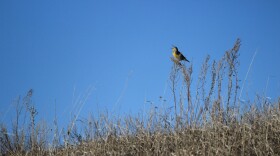It must be a good year for cottonwoods. I have heard several comments about all the cotton wafting in the wind this summer. Occasionally someone will ask why some cottonwood trees always produce cotton while others do not. Cottonwood is rather unusual in that they are dioecious, meaning the plant is either a male or female. It is the female trees that produce the cotton.
There is a seed in amongst all those tufts of cotton wafting in the breeze, of course. But it is hardly noticeable without a closer look. Small seeds like that do not provide much energy for the seedling to develop. Even though each tree may produce somewhere around 25 million seeds each year, the chances a particular seed will land in a site conducive to establishment is rare.
There is no dormancy in cottonwood seeds, and the seeds remain viable for only a week or two. Plus, to germinate, a seed will need to land on moist soil with full sunlight. Successful establishment is largely dependent upon seasonal flooding where there is moist soil and little or no plant cover. If the upper layers of soil can stay moist for one to three weeks and gets full sunlight, the seedling has a good chance of becoming established. If the soil dries up or becomes shaded, all bets are off.
The native range for eastern cottonwood is roughly from the Great Plains eastward. They are fast growing trees that live to around 100-200 years. In our region cottonwood is often associated with floodplains and bottomland forests that experience periodic flooding. They may also be found in wet meadows and some wetlands, sometimes as a band of trees running along the margin of the wetland where the trees were established during a high-water year when a band of bare soil stayed wet for a considerable period.
One can see young cottonwoods around the state along wetlands, rivers, and streams. However, not so much anymore on the Missouri River. Historically the forested bottomlands of the Missouri River were dominated by cottonwood. The annual flooding created excellent germination conditions for cottonwood seeds, producing large and extensive stands of them. The construction of Garrison Dam, however, changed all that. Annual flooding no longer occurs on the old floodplain downstream. Conditions are now more suitable to green ash. So those old cottonwood bottoms are giving way to green ash. To get a sense of what the floodplain used to look like, make a point of visiting Smith Grove, located a few miles south of Cross Ranch State Park. But do it soon because many of those old patriarchs and matriarchs are dead or dying. They will not be standing much longer.




